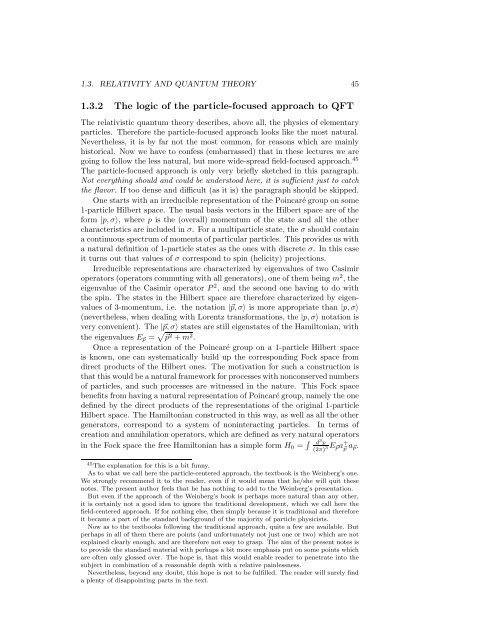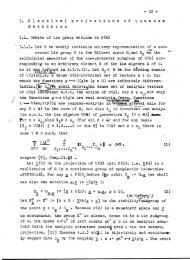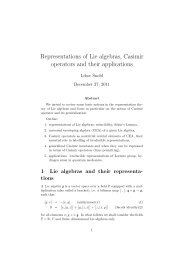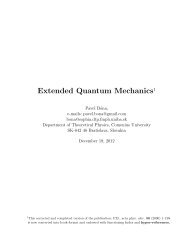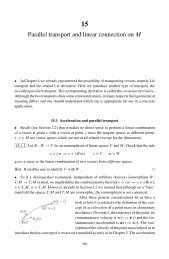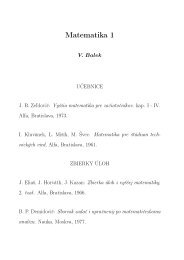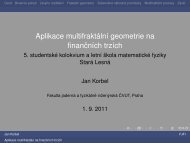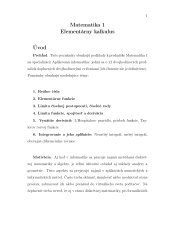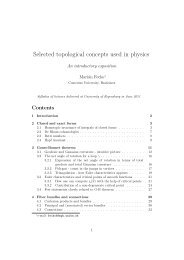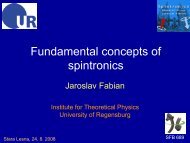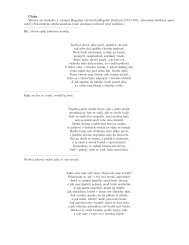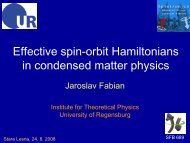Quantum Field Theory I
Quantum Field Theory I
Quantum Field Theory I
You also want an ePaper? Increase the reach of your titles
YUMPU automatically turns print PDFs into web optimized ePapers that Google loves.
1.3. RELATIVITY AND QUANTUM THEORY 45<br />
1.3.2 The logic of the particle-focused approach to QFT<br />
The relativistic quantum theory describes, above all, the physics of elementary<br />
particles. Therefore the particle-focused approach looks like the most natural.<br />
Nevertheless, it is by far not the most common, for reasons which are mainly<br />
historical. Now we have to confess (embarrassed) that in these lectures we are<br />
going to follow the less natural, but more wide-spread field-focused approach. 45<br />
The particle-focused approach is only very briefly sketched in this paragraph.<br />
Not everything should and could be understood here, it is sufficient just to catch<br />
the flavor. If too dense and difficult (as it is) the paragraph should be skipped.<br />
One starts with an irreducible representation of the Poincaré group on some<br />
1-particle Hilbert space. The usual basis vectors in the Hilbert space are of the<br />
form |p,σ〉, where p is the (overall) momentum of the state and all the other<br />
characteristics are included in σ. For a multiparticle state, the σ should contain<br />
a continuousspectrum ofmomentaofparticularparticles. This providesus with<br />
a natural definition of 1-particle states as the ones with discrete σ. In this case<br />
it turns out that values of σ correspond to spin (helicity) projections.<br />
Irreducible representations are characterized by eigenvalues of two Casimir<br />
operators (operators commuting with all generators), one of them being m 2 , the<br />
eigenvalue of the Casimir operator P 2 , and the second one having to do with<br />
the spin. The states in the Hilbert space are therefore characterized by eigenvalues<br />
of 3-momentum, i.e. the notation |⃗p,σ〉 is more appropriate than |p,σ〉<br />
(nevertheless, when dealing with Lorentz transformations, the |p,σ〉 notation is<br />
very convenient). The |⃗p,σ〉 states are still eigenstates of the Hamiltonian, with<br />
the eigenvalues E ⃗p = √ ⃗p 2 +m 2 .<br />
Once a representation of the Poincaré group on a 1-particle Hilbert space<br />
is known, one can systematically build up the corresponding Fock space from<br />
direct products of the Hilbert ones. The motivation for such a construction is<br />
thatthiswouldbeanaturalframeworkforprocesseswithnonconservednumbers<br />
of particles, and such processes are witnessed in the nature. This Fock space<br />
benefits from having a natural representation of Poincarégroup, namely the one<br />
defined by the direct products of the representations of the original 1-particle<br />
Hilbert space. The Hamiltonian constructed in this way, as well as all the other<br />
generators, correspond to a system of noninteracting particles. In terms of<br />
creation and annihilation operators, which are defined as very natural operators<br />
in the Fock space the free Hamiltonian has a simple form H 0 = ∫ d 3 p<br />
(2π) 3 E ⃗p a + ⃗p a ⃗p.<br />
45 The explanation for this is a bit funny.<br />
As to what we call here the particle-centered approach, the textbook is the Weinberg’s one.<br />
We strongly recommend it to the reader, even if it would mean that he/she will quit these<br />
notes. The present author feels that he has nothing to add to the Weinberg’s presentation.<br />
But even if the approach of the Weinberg’s book is perhaps more natural than any other,<br />
it is certainly not a good idea to ignore the traditional development, which we call here the<br />
field-centered approach. If for nothing else, then simply because it is traditional and therefore<br />
it became a part of the standard background of the majority of particle physicists.<br />
Now as to the textbooks following the traditional approach, quite a few are available. But<br />
perhaps in all of them there are points (and unfortunately not just one or two) which are not<br />
explained clearly enough, and are therefore not easy to grasp. The aim of the present notes is<br />
to provide the standard material with perhaps a bit more emphasis put on some points which<br />
are often only glossed over. The hope is, that this would enable reader to penetrate into the<br />
subject in combination of a reasonable depth with a relative painlessness.<br />
Nevertheless, beyond any doubt, this hope is not to be fulfilled. The reader will surely find<br />
a plenty of disappointing parts in the text.


